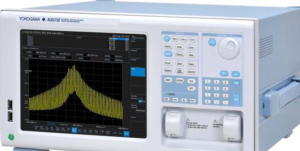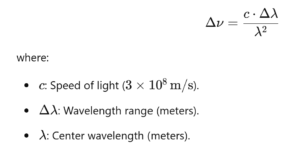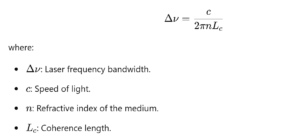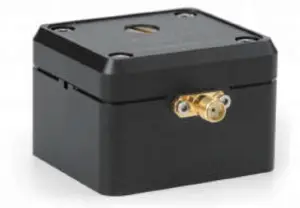Laser frequency bandwidth refers to the range of frequencies over which the laser emits light, typically expressed in hertz (Hz). It is a measure of the spread of optical frequencies in the laser’s emission spectrum and is distinct from laser linewidth, which often describes the central peak’s width.
Below are several methods to measure a laser’s frequency bandwidth, depending on the precision and tools available:
1. Using an Optical Spectrum Analyzer (OSA)

- Principle: The OSA directly measures the spectral power distribution of the laser across a frequency or wavelength range.
- Procedure:
- Connect the laser output to the input port of the OSA.
- Set the OSA to the appropriate resolution bandwidth and scanning range.
- Record the spectrum of the laser emission.
- Identify the range of frequencies (or wavelengths) where the emission is significant.
- Convert the wavelength range (Δλ) into frequency bandwidth (Δν) using:

- Advantages:
- Simple setup.
- Suitable for broader bandwidths (e.g., nanometer scales, GHz frequency ranges).
- Disadvantages:
- Suitable for broader bandwidths (e.g., nanometer scales, GHz frequency ranges).
2. Self-Heterodyne Interferometry
- Principle: Measures the frequency noise and distribution by splitting the laser output into two parts and analyzing the interference pattern.
- Procedure:
- Split the laser beam using a beam splitter.
- Send one part through a long fiber delay (to decorrelate phase noise).
- Combine the delayed and undelayed signals on a fast photodetector.
- Measure the beat note spectrum using an RF spectrum analyzer.
- The range of frequencies in the beat note corresponds to the laser bandwidth.
- Advantages:
- Suitable for narrowband lasers.
- Accurate for kHz-level measurements.
- Disadvantages:
- Requires long delay fibers for ultra-narrow bandwidths.
- Bulky and complex setup.
3. Fabry-Perot Interferometer (FPI)
- Principle: A Fabry-Perot etalon acts as a high-resolution spectral analyzer, measuring the transmission spectrum of the laser.
- Procedure:
- Pass the laser beam through a high-finesse Fabry-Perot cavity.
- Measure the transmitted intensity as a function of frequency or wavelength.
- The range of frequencies where the laser shows significant transmission corresponds to the bandwidth.
- Advantages:
- High precision for both narrowband and broadband lasers.
- Disadvantages:
- Requires a stable Fabry-Perot etalon.
- Limited to laboratory use due to complexity.
4. Coherence Length Method
- Principle: The coherence length of a laser is inversely proportional to its frequency bandwidth.
- Formula:

- Procedure:
- Measure the coherence length (LC) using an interferometer, such as a Michelson interferometer.
- Use the formula above to calculate the bandwidth.
- Advantages:
- Simple and cost-effective for experimental setups.
- Disadvantages:
- Precision depends on accurate coherence length measurement.
5. Time-Domain Measurement
- Principle: Analyze the time-domain pulse characteristics to determine the laser’s frequency bandwidth, especially for pulsed lasers.
- Procedure:
- Measure the duration of the laser pulse (Δt) using an autocorrelator or fast photodetector.
- Calculate the frequency bandwidth using the time-bandwidth product: Δν⋅Δt≥K where K is a constant depending on the pulse shape (e.g., K=0.44 for a Gaussian pulse).
- Advantages:
- Suitable for ultrafast pulsed lasers.
- Disadvantages:
- Not applicable for continuous-wave (CW) lasers.
6. Beat Frequency with a Reference Laser
- Principle: Combines the test laser with a known reference laser, and the difference in frequencies (beat frequency) is analyzed.
- Procedure:
- Use a beam splitter to combine the test laser and a stable reference laser on a fast photodetector.
- Analyze the beat frequency spectrum using an RF spectrum analyzer.
- The width of the beat spectrum corresponds to the bandwidth of the test laser.
- Advantages:
- Highly precise when a stable reference laser is available.
- Disadvantages:
- Requires a reference laser with a narrower bandwidth than the test laser.
Which Method is the Best?
- For Narrowband Lasers (< MHz): Use self-heterodyne interferometry or Fabry-Perot interferometry.
- For Broadband Lasers (> GHz): Use optical spectrum analyzer or time-domain measurement.
- For Medium Bandwidths (MHz to GHz): Beat frequency with a reference laser is highly accurate.
Summary
Laser frequency bandwidth is typically measured using methods like:
- Optical Spectrum Analyzers for broader bandwidths.
- Self-Heterodyne Interferometry for narrow linewidths.
- Fabry-Perot Interferometry for precise spectral measurements.
- Coherence Length Techniques for simplified calculations. The choice of method depends on the laser’s frequency range and the measurement precision required.
- Principle: The OSA directly measures the spectral power distribution of the laser across a frequency or wavelength range.
- Procedure:
- Connect the laser output to the input port of the OSA.
- Set the OSA to the appropriate resolution bandwidth and scanning range.
- Record the spectrum of the laser emission.
- Identify the range of frequencies (or wavelengths) where the emission is significant.
- Convert the wavelength range (Δλ) into frequency bandwidth (Δν) using:

- Advantages:
- Simple setup.
- Suitable for broader bandwidths (e.g., nanometer scales, GHz frequency ranges).
- Disadvantages:
- Suitable for broader bandwidths (e.g., nanometer scales, GHz frequency ranges).
2. Self-Heterodyne Interferometry
- Principle: Measures the frequency noise and distribution by splitting the laser output into two parts and analyzing the interference pattern.
- Procedure:
- Split the laser beam using a beam splitter.
- Send one part through a long fiber delay (to decorrelate phase noise).
- Combine the delayed and undelayed signals on a fast photodetector.
- Measure the beat note spectrum using an RF spectrum analyzer.
- The range of frequencies in the beat note corresponds to the laser bandwidth.
- Advantages:
- Suitable for narrowband lasers.
- Accurate for kHz-level measurements.
- Disadvantages:
- Requires long delay fibers for ultra-narrow bandwidths.
- Bulky and complex setup.
3. Fabry-Perot Interferometer (FPI)
- Principle: A Fabry-Perot etalon acts as a high-resolution spectral analyzer, measuring the transmission spectrum of the laser.
- Procedure:
- Pass the laser beam through a high-finesse Fabry-Perot cavity.
- Measure the transmitted intensity as a function of frequency or wavelength.
- The range of frequencies where the laser shows significant transmission corresponds to the bandwidth.
- Advantages:
- High precision for both narrowband and broadband lasers.
- Disadvantages:
- Requires a stable Fabry-Perot etalon.
- Limited to laboratory use due to complexity.
4. Coherence Length Method
- Principle: The coherence length of a laser is inversely proportional to its frequency bandwidth.
- Formula:

- Procedure:
- Measure the coherence length (LC) using an interferometer, such as a Michelson interferometer.
- Use the formula above to calculate the bandwidth.
- Advantages:
- Simple and cost-effective for experimental setups.
- Disadvantages:
- Precision depends on accurate coherence length measurement.
5. Time-Domain Measurement
- Principle: Analyze the time-domain pulse characteristics to determine the laser’s frequency bandwidth, especially for pulsed lasers.
- Procedure:
- Measure the duration of the laser pulse (Δt) using an autocorrelator or fast photodetector.
- Calculate the frequency bandwidth using the time-bandwidth product: Δν⋅Δt≥K where K is a constant depending on the pulse shape (e.g., K=0.44 for a Gaussian pulse).
- Advantages:
- Suitable for ultrafast pulsed lasers.
- Disadvantages:
- Not applicable for continuous-wave (CW) lasers.
6. Beat Frequency with a Reference Laser
- Principle: Combines the test laser with a known reference laser, and the difference in frequencies (beat frequency) is analyzed.
- Procedure:
- Use a beam splitter to combine the test laser and a stable reference laser on a fast photodetector.
- Analyze the beat frequency spectrum using an RF spectrum analyzer.
- The width of the beat spectrum corresponds to the bandwidth of the test laser.
- Advantages:
- Highly precise when a stable reference laser is available.
- Disadvantages:
- Requires a reference laser with a narrower bandwidth than the test laser.
Which Method is the Best?
- For Narrowband Lasers (< MHz): Use self-heterodyne interferometry or Fabry-Perot interferometry.
- For Broadband Lasers (> GHz): Use optical spectrum analyzer or time-domain measurement.
- For Medium Bandwidths (MHz to GHz): Beat frequency with a reference laser is highly accurate.
Summary
Laser frequency bandwidth is typically measured using methods like:
- Optical Spectrum Analyzers for broader bandwidths.
- Self-Heterodyne Interferometry for narrow linewidths.
- Fabry-Perot Interferometry for precise spectral measurements.
- Coherence Length Techniques for simplified calculations. The choice of method depends on the laser’s frequency range and the measurement precision required.





